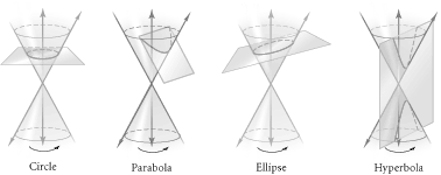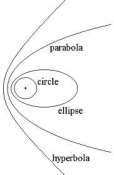

Two Newcomers from Oort
Comet C/2011 L4 or as the media mistakenly calls it -- PANSTARRS is making its debut in the inner solar system. I haven't managed to get a picture yet due to cloudy western horizons at dusk. The eccentricity of C2011 L4 is pretty close to one (1.000087). You will recall from the chapter on conic sections which your algebra, trig, and calculus teachers brushed on briefly or skipped completely (you were cheated), that an eccentricity of one is parabolic and greater than one is hyperbolic. An eccentricity of 0 is a perfect circle and between 0 and 1 is an ellipse. Real orbits are rarely perfectly circular or parabolic. Earth's orbit is an ellipse with an eccentricity of 0.0167. Comets with eccentricities just less than 1 will have very long periods. Halley's comet has an eccentricity of 0.967 and returns every 75.3 years. Hale-Bopp has an eccentricity of .995 and a period of about 2500 years. C/2011 L4 will not return for at least 106,000 years and could perhaps just escape the solar system. Neptune has an orbital period of 165 years and Pluto 246 years. So where the heck did C/2011 L4 come from?


In order to discuss C/2011 L4's origin, let's construct a handy scale model of our solar system using, hmmm, how about a football field? It's not that I particularly care for football. But football fields are conveniently large and have a nice number line divided into a 100 parts. The first step is to decide the scale of our field and I'll choose to use astronomical units which is just the earth-sun distance or 92,955,807.273 miles. Feel free to think of it as 93 million miles. For our football field solar system, we'll set each yard equal to 1 AU and thus it will have a diameter of 100 AU's. The sun has a diameter of about 860,000 miles which is pretty close to 1/100 of an AU so we can put a coffee bean at the 50 yard line to represent a 1 cm sun. The earth will be 1/10 of a millimeter at the one yard line -- a small grain of sand. Jupiter's diameter is about 87,000 miles so it will be a full millimeter in diameter placed about 5 yards and 1 foot from the sun. The outermost planet -- Neptune will be 2.76 billion miles from the sun or 30.1 yards from the sun. From the 20 yard line to the goal line is the Kuiper belt which includes Pluto, Makemake, Haumea, Ixion, Varuna, and more than a thousand known KBO's. Unlike the asteroid belt and the planets, the Kuiper belt is more of a torus or a donut. Some of the objects have orbits inclined by as much as 30 degrees to the plane of the ecliptic.
| Object | Distance (AU) | Field Position |
|---|---|---|
| Mercury | .387 | 1ft 2in |
| Venus | .723 | 2ft 2in |
| Earth | 1 | 1 yd |
| Mars | 1.523 | 4ft 7in |
| Asteroid Belt | 2.1 to 3.2 | |
| Jupiter | 5.204 | 5yd 7in |
| Saturn | 9.582 | 9yd 1ft 9in |
| Uranus | 19.229 | 19yd 8in |
| Neptune | 30.104 | 30yd 3in |
| Kuiper Torus | 30 to 50 | 30yd to 50 yd |
| Oort Cloud | 2,000 to 50,000 | 1.5mi to 30mi |

C/2011 L4 has an orbital inclination to the plane of 84.2 degrees. It simply isn't from the football field. The tails of comets are from the sublimation of ice, methane, and other frozen volatiles. Close passage to the sun heats them and drives them off. Eventually all volatiles disappear and only a rocky body is left. Some of the material may get scattered along its orbit and become an annual meteor shower. Thus, all comets must be relative new comers to the inner solar system. So where do they come from? The answer is the hypothetical Oort cloud. We'll add it to our solar system model. It will begin about 2000 AU's or 1.5 football field miles from the sun and extend out to 30 miles from the center of the football field, or almost a light year. (The Alpha Centauri system would be more than 130 miles from our 50 yard line.) The Oort cloud is a spherical distribution of objects, so they can come from any direction and even orbit backwards compared to planetary orbits. Most comets must originate in the Oort cloud and some are captured by Jupiter to become short period comets. Another Oort cloud object will make an appearance at the end of November this year -- C/2012 S1, which the press incorrectly dubbed ISON. (ISON was the group that discovered it and they will likely discover others.) C/2012 S1 is likely to be much brighter than C/2011 L4 as it will be a sun grazer -- passing 680,000 miles above the sun's surface (compared to 29 million miles for C/2011 L4). That's just 1 and half times the sun's radius and may be close enough to disintegrate the comet. If it survives, it could be quite bright. Some sources say that it could be brighter than the full moon, but that is relatively meaningless to observers since it will be too close to the sun to see while it is that bright. It is possible that it will be as bright as Venus when we are able to see it. C/2012 S1 will be a one time visitor to the inner solar system. It's trajectory will take it into deep space in the direction of Castor (αGem).

C/2011 L4 is behind that cloud